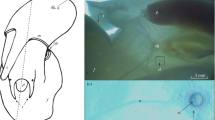Summary
-
1.
Single statolith-hair and free-hook-hair receptors were studied in isolated parts of the statocyst of the crabScylla serrata.
-
2.
Upon deflection of single hairs the responses of the statolith-hair and free-hook-hair receptors are essentially similar. The receptors have a phasic-tonic response pattern (Figs. 5B and 12), a fan-shaped directionality (Figs. 3, 8B and 11), and their stimulus-response plots saturate (Figs. 6 and 13).
-
3.
Statolith and free-hook hairs bend most easily in the plane formed by the hair and its hook. The main sensitivity of the receptors is in this plane and into or opposite to the direction in which the hooks point (Figs. 3 and 11).
-
4.
The hooks of the great majority of the free-hook hairs are directed dorso-ventrally (Fig. 11D). The position of the hairs relative to the statocyst wall is not affected by gravity. On the basis of the anatomy of the hairs and the properties of their receptors it is suggested that the free-hook-hair receptors provide the crab with a system which measures head-up movements independent of the position of the body in space.
-
5.
The statolith hairs are arranged in two concentric rows. Their hooks point to the centre, perpendicular to the rows of hairs. When stimulated by displacing the statolith the hair receptors of the inner row respond phasically (Figs. 4 and 5). The directionality (Fig. 3) and stimulus-response plots (Fig. 6) of the receptors when stimulated by displacing the statolith are similar to those of receptors stimulated by deflecting single hairs. It is concluded that the hair receptors of the inner row inform the crab about the direction and amplitude of the positional changes but that they can not code for the absolute position of the body in space.
-
6.
The response properties of the hair receptors of the outer row are affected to a great extent by the attachment of the statolith to the hairs. Low-frequency lateral displacements of the statolith into any direction suppress the activity of the receptors (Fig. 8A). High-frequency statolith displacements or vibrations activate the hair receptors (Fig. 7). The significance of these response properties for the function of the hair receptors of the outer row in eye withdrawal behaviour of the crab is discussed.
Similar content being viewed by others
References
Cohen, M.J.: The function of receptors in the statocyst of the lobsterHomarus americanus. J. Physiol. (London)130, 9–34 (1955)
Cohen, M.J.: The response patterns of single receptors in the crusacean statocyst. Proc. R. Soc. (London) Biol.152, 30–48 (1960)
Cohen, M.J., Dijkgraaf, S.: Mechanoreception. In: The physiology of Crustacea, Vol. II. Waterman, T.H. (ed.), pp. 65–108 (1961)
Dijkgraaf, S.: Structure and functions of the statocyst in crabs. Experientia12, 394–396 (1956)
Dunn, P.A.: Anatomy and physiology of hair receptors in the statocyst of the crabScylla serrata. Ph. D. Thesis, Australian National University (1975)
Fraser, P.J.: Free hook hair and thread hair input to fibre 5 in the mud crabScylla serrata during antennule rotation. J. Comp. Physiol.103, 291–313 (1975)
Fraser, P.J., Sandeman, D.C.: Effects of angular and linear accelertion on semicircular canal interneurons of the crabScylla serrata. J. Comp. Physiol.96, 205–221 (1975)
Horridge, G.A.: Adaptation and other phenomena in the optoinetic response of the crab,Carcinus. J. Exp. Biol.44, 285–295 (1966)
Janse, C., Sandeman, D.C.: The role of the fluid-filled balance organs in the induction of phase and gain in the compensatory eye reflex of the crabScylla serrata. J. Comp. Physiol.130, 95–100 (1979a)
Janse, C., Sandeman, D.C.: The significance of canal-receptor proerties for the induction of phase and gain in the fluid-filled balance organs of the crabScylla serrata. J. Comp. Physiol.130, 101–111 (1979b)
Loewenstein, W.R.: Mechano-electric transduction in the pacinian corpuscle. Initiation of sensory impulses in mechanoreceptors. In: Handbook of sensory physiology, Vol. I. Loewenstein, W.R. (ed.), pp. 269–290. Berlin, Heidelberg, New York: Springer 1971
Ozeki, M., Takahata, M., Hisada, M.: Afferent response patterns of the crayfish statocyst with ferrite grain statolith to magnetic field stimulation. J. Comp. Physiol.123, 1–10 (1978)
Sandeman, D.C.: Dynamic receptors in the statocyst of crabs. Fortschr. Zool.23, 185–192 (1975)
Sandeman, D.C., Okajima, A.: Statocyst induced eye movements in the crabScylla serrata. I. The sensory input from the statoyst. J. Exp. Biol.57, 187–204 (1972)
Sandeman, D.C., Okajima, A.: Statocyst-induced eye movements in the crabScylla serrata. III. The anatomical projections of sensory and motor neurones and the responses of the motor neurones. J. Exp. Biol.59, 17–38 (1973)
Schöne, H.: On the transformation of the gravity input into reacions by statolith organs of the “fan” type. Fortschr. Zool.23, 120–128 (1975)
Silvey, G.E., Dunn, P.A., Sandeman, D.C.: Integration between statocyst sensory neurons and oculomotor neurons in the crabScylla serrata. II. The thread hair sensory receptors. J. Comp. Physiol.108, 45–52 (1976)
Stein, A.: Attainment of positional information in the crayfish statocyst. Fortschr. Zool.23, 109–119 (1975)
Takahata, M., Hisada, M.: Functional polarization of statocyst receptors in the crayfishProcambarus clarkii Girard. J. Comp. Physiol.130, 201–207 (1979)
Author information
Authors and Affiliations
Additional information
The author thanks the Free University of Amsterdam and the IBRO for financial support, the members of the Department of Biology (Division Zoology) of the Free University, Amsterdam for reading the manuscript, Mr. G.W.H. van den Berg and Mr. C. van Groenigen for their help in preparing the figures and Mrs. P.F.M. Ohr-Bulder for typing the manuscript.
Rights and permissions
About this article
Cite this article
Janse, C. The function of statolith-hair and free-hook-hair receptors. J. Comp. Physiol. 137, 51–62 (1980). https://doi.org/10.1007/BF00656917
Accepted:
Issue Date:
DOI: https://doi.org/10.1007/BF00656917




